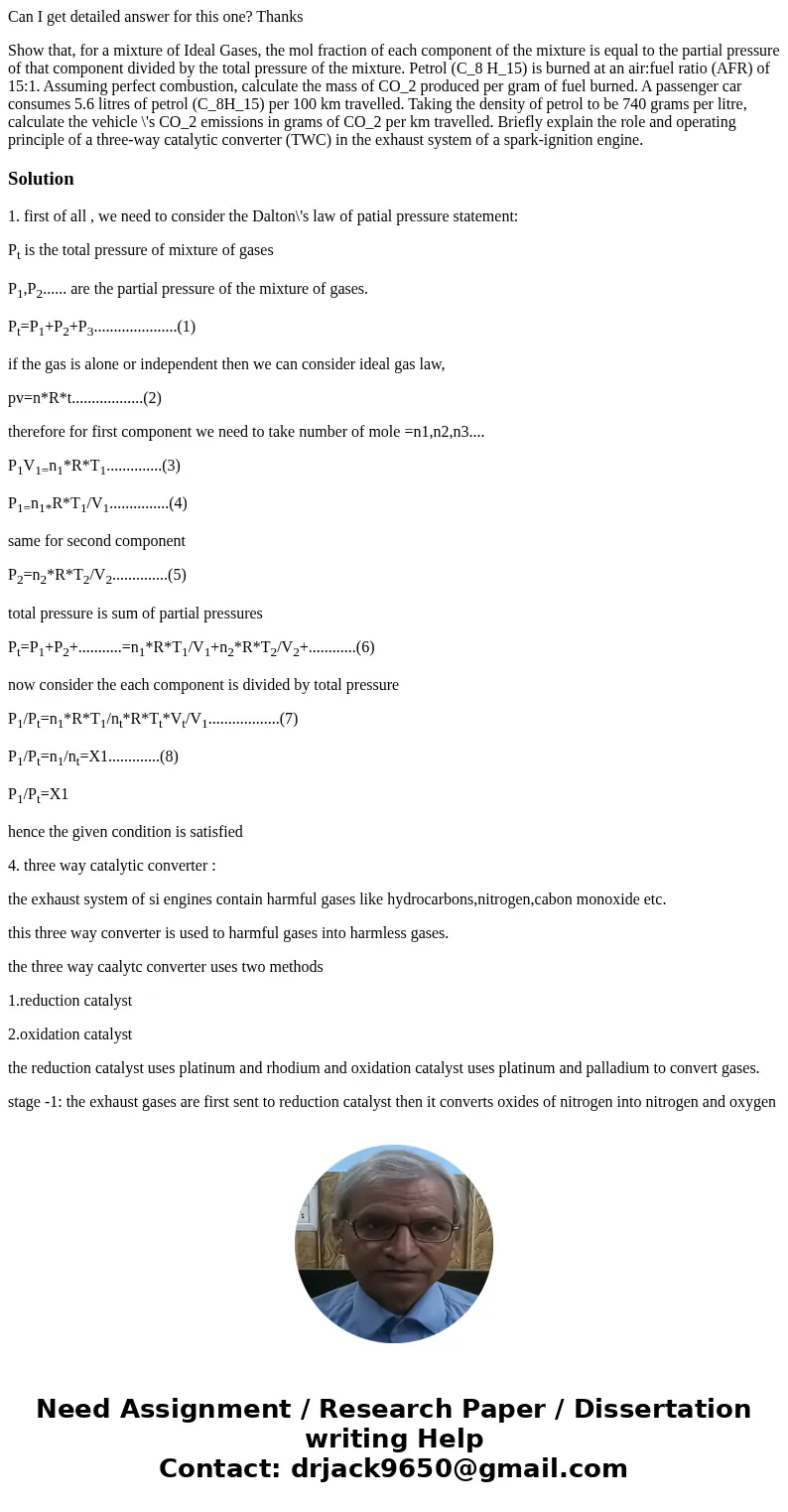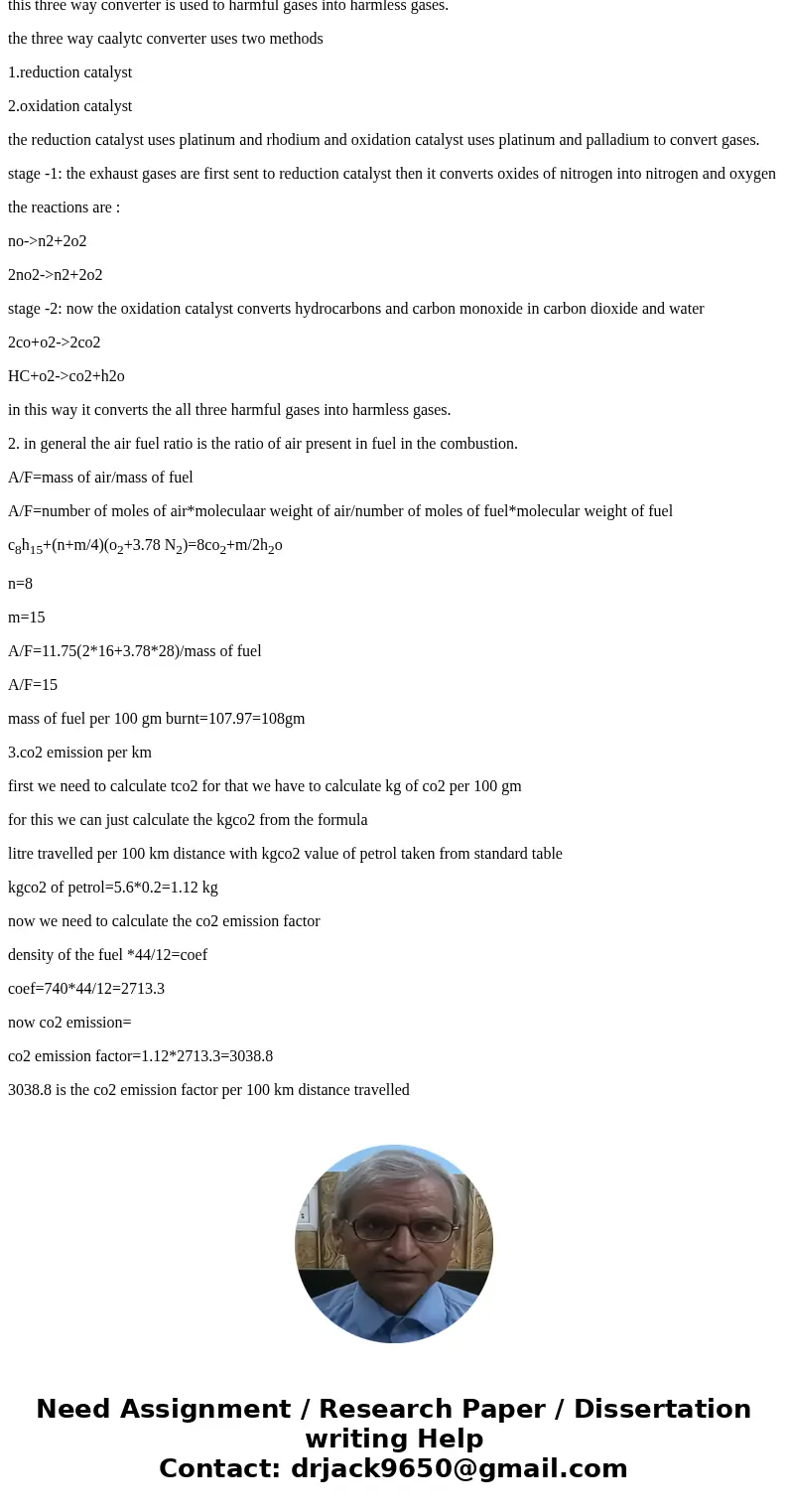Can I get detailed answer for this one Thanks Show that for
Can I get detailed answer for this one? Thanks
Show that, for a mixture of Ideal Gases, the mol fraction of each component of the mixture is equal to the partial pressure of that component divided by the total pressure of the mixture. Petrol (C_8 H_15) is burned at an air:fuel ratio (AFR) of 15:1. Assuming perfect combustion, calculate the mass of CO_2 produced per gram of fuel burned. A passenger car consumes 5.6 litres of petrol (C_8H_15) per 100 km travelled. Taking the density of petrol to be 740 grams per litre, calculate the vehicle \'s CO_2 emissions in grams of CO_2 per km travelled. Briefly explain the role and operating principle of a three-way catalytic converter (TWC) in the exhaust system of a spark-ignition engine.Solution
1. first of all , we need to consider the Dalton\'s law of patial pressure statement:
Pt is the total pressure of mixture of gases
P1,P2...... are the partial pressure of the mixture of gases.
Pt=P1+P2+P3.....................(1)
if the gas is alone or independent then we can consider ideal gas law,
pv=n*R*t..................(2)
therefore for first component we need to take number of mole =n1,n2,n3....
P1V1=n1*R*T1..............(3)
P1=n1*R*T1/V1...............(4)
same for second component
P2=n2*R*T2/V2..............(5)
total pressure is sum of partial pressures
Pt=P1+P2+...........=n1*R*T1/V1+n2*R*T2/V2+............(6)
now consider the each component is divided by total pressure
P1/Pt=n1*R*T1/nt*R*Tt*Vt/V1..................(7)
P1/Pt=n1/nt=X1.............(8)
P1/Pt=X1
hence the given condition is satisfied
4. three way catalytic converter :
the exhaust system of si engines contain harmful gases like hydrocarbons,nitrogen,cabon monoxide etc.
this three way converter is used to harmful gases into harmless gases.
the three way caalytc converter uses two methods
1.reduction catalyst
2.oxidation catalyst
the reduction catalyst uses platinum and rhodium and oxidation catalyst uses platinum and palladium to convert gases.
stage -1: the exhaust gases are first sent to reduction catalyst then it converts oxides of nitrogen into nitrogen and oxygen
the reactions are :
no->n2+2o2
2no2->n2+2o2
stage -2: now the oxidation catalyst converts hydrocarbons and carbon monoxide in carbon dioxide and water
2co+o2->2co2
HC+o2->co2+h2o
in this way it converts the all three harmful gases into harmless gases.
2. in general the air fuel ratio is the ratio of air present in fuel in the combustion.
A/F=mass of air/mass of fuel
A/F=number of moles of air*moleculaar weight of air/number of moles of fuel*molecular weight of fuel
c8h15+(n+m/4)(o2+3.78 N2)=8co2+m/2h2o
n=8
m=15
A/F=11.75(2*16+3.78*28)/mass of fuel
A/F=15
mass of fuel per 100 gm burnt=107.97=108gm
3.co2 emission per km
first we need to calculate tco2 for that we have to calculate kg of co2 per 100 gm
for this we can just calculate the kgco2 from the formula
litre travelled per 100 km distance with kgco2 value of petrol taken from standard table
kgco2 of petrol=5.6*0.2=1.12 kg
now we need to calculate the co2 emission factor
density of the fuel *44/12=coef
coef=740*44/12=2713.3
now co2 emission=
co2 emission factor=1.12*2713.3=3038.8
3038.8 is the co2 emission factor per 100 km distance travelled


 Homework Sourse
Homework Sourse